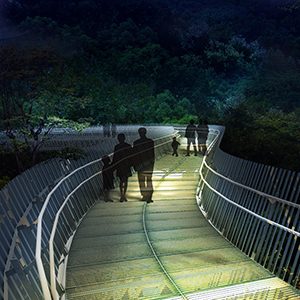Sustainable urban canopee design projects
Here is a short overview of some urban canopee projects reconciling or linking city and nature. This, in perfect coexistence and respect for the fauna and flora!
Of course, China, in a major evolution period, is an example.
At the heart of a frightening and dramatic pollution, the country deploys vast projects of urbanism and greening designed to make a breathable atmosphere in the cities.
China is, thus, the place for new forests creation… And some architectural projects compete with technicity and creativity to demonstrate a perfect cohabitation between city and forest.
Futuristic design: a urban canopee in harmonious cohabitation with the city!
The LOOK architects Agency founded in 1993 and headquartered in Singapore, seems to specialize in futuristic and grandiose projects in Asia.
Several times awarded for the creation of unique architecture and innovative urban design, the agency is commited to the design of the future.
Opposite photos: Alexandra arch & forest walk, gateway to nature through the tree tops (year of completion: 2008).
Observation towers, pedestrian bridge designed for walk or contemplation through the tree tops, are at the heart of the project.
New networks are reinvented and connect urban spaces. Here the infrastructure allows the public to cross the Park Telok Blangah Hill, natural heritage of Singapore, while offering a breathtaking and amazing view on the impenetrable forest!
MORE DETAILS ON THIS LINK
Ecology first: trees resilient to floods!
The TURENSCAPE Agency, founded in 1998 and based in Beijing, has planned and designed more than 300 ecological cities and 1000 landscape projects in China.
A river ecological corridor
A poetic landscape that is no less technical thanks to resilient plantations chosen to adapt to the annual monsoon’ floods.
The bridge and pathways have been designed to adapt to the dynamic streams and flows of people.
The Agency indicates that ‘ the bridge and the paths connect the city to nature and connect the past to the future ‘.
Winding paths and terraces offer intimate and shady spaces to people.
As a result, this river ecological corridor reduced the pollution that was present and offered opportunities for urban land development while serving ecological functions.
MORE DETAILS ON THIS LINK.
Ecology, free nature and open urban environment
The Ilex landscapes Agency, based in Lyon, has designed this alluvial forest of 45 hectares next to the “Parc de la Tete d’Or ” and the “international city” of Lyon. This space has been designed to reconcile public functions with the natural quality of the site, in this urban area.
An alluvial forest in the city centre
The project aims to allow the spontaneous regeneration of plants. On the other hand a sustainable management is adapted to the needs of the municipality.
MORE DETAILS ON THIS LINK.
What about new vertical forests designs?
What about new vertical forests designs? Can a such called ‘ vertical forest ‘ be described as a sustainable, environmentally and tree friendly ?
If these designs gain great success, it may be because they recall a tree hut, a urban hut more precisely…
Of course, considering the lack of space available in the city, the proposals for green walls and roofs form an inventive resource. But should we use trees? At what price?
The so-called ‘ vertical forest ‘ design projects do not consider the function of a tree, its biology, its lifespan, its architecture or its equally important relationship with the soil in which it is planted. Trees vital needs are ignored.
–trees roots are ignored: no possible deployment for an autonomous search of water and minerals or the possibility of anchoring in the long term. The maintenance of trees is, as a result, strongly attended.
–is the space allocated to trees sufficient for the deployment of their adult-sized Crown?
–mature size trees, already weakened by roots amputated many times, are transplanted again and again… and planted in containers.
–Trees are overexposed to the urban heat between concrete and glazing. Outside in their natural habitat, they are subjected, in height, to high wind speeds and to different environmental pressures.
-Construction and management are very costly! what about watering? tree care? monitoring of phytosanitary issues? replacement of dead trees?
-what about mycorrhizae and other organisms that participate in the recreation of humus?
-the estimated lifespan of tree is…?
-etc.
Of course, trees do absorb carbon dioxide and help eliminate pollution in the city. But do we have to consider them as disposable products or a lucrative concept?

